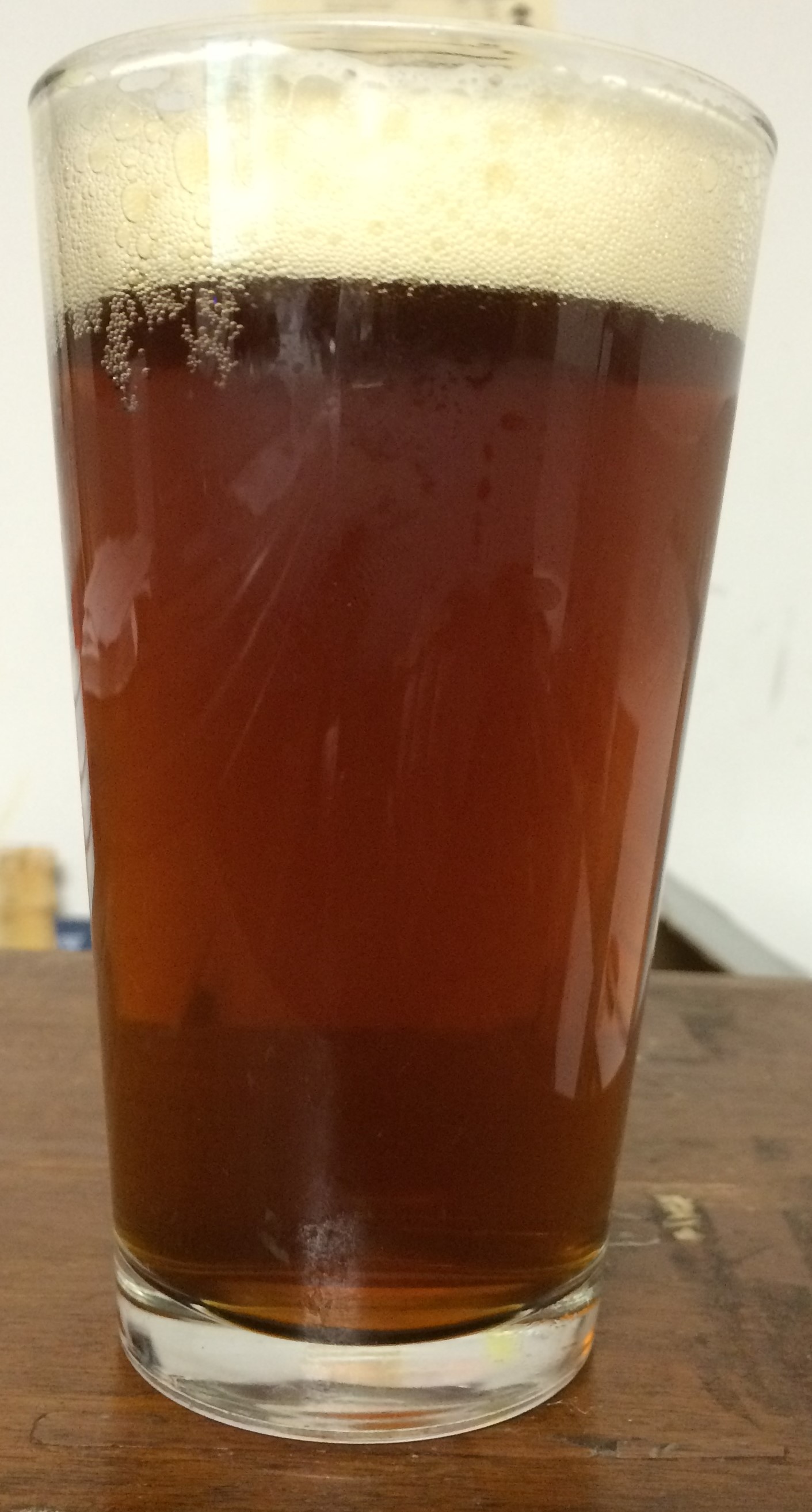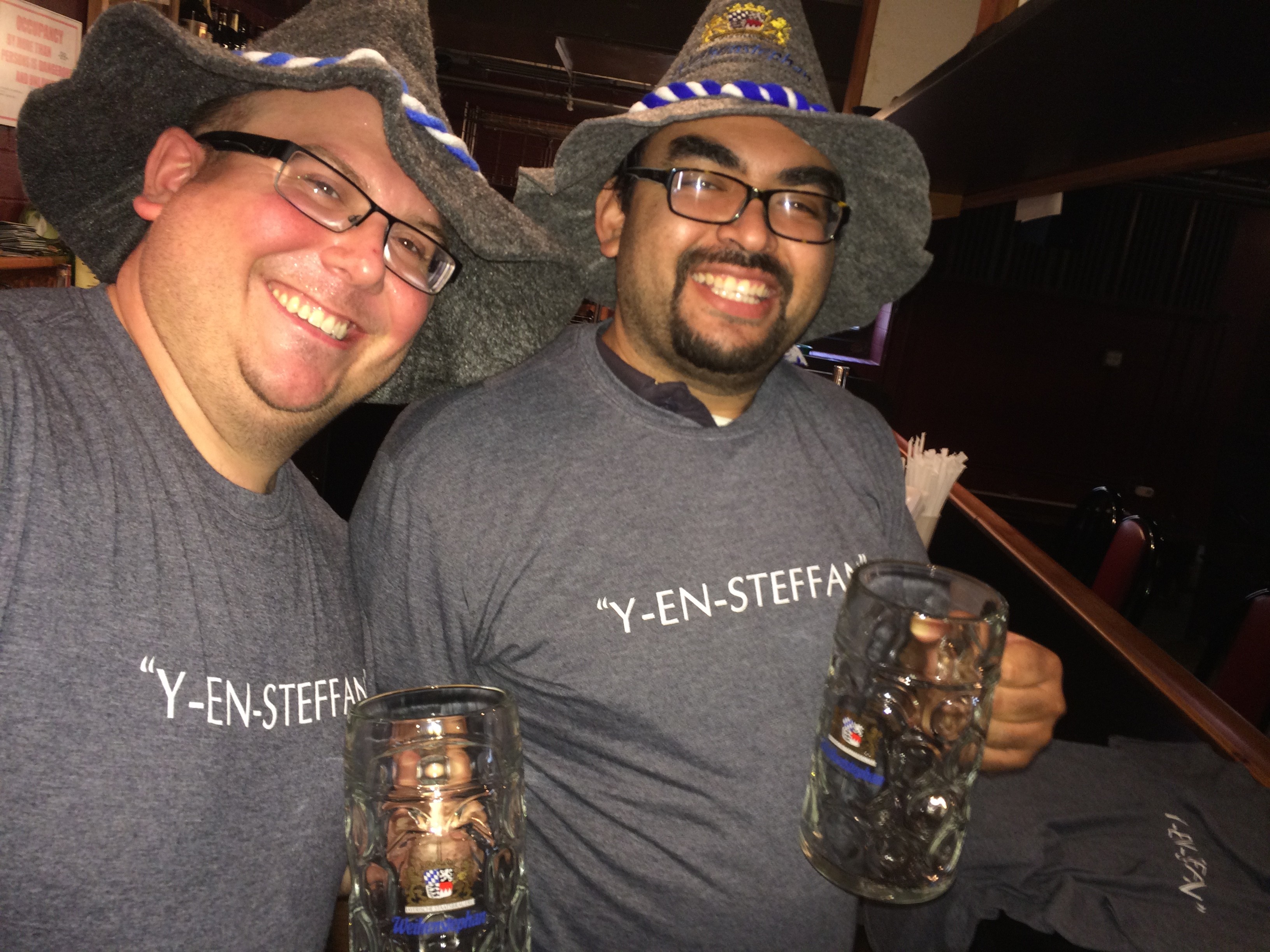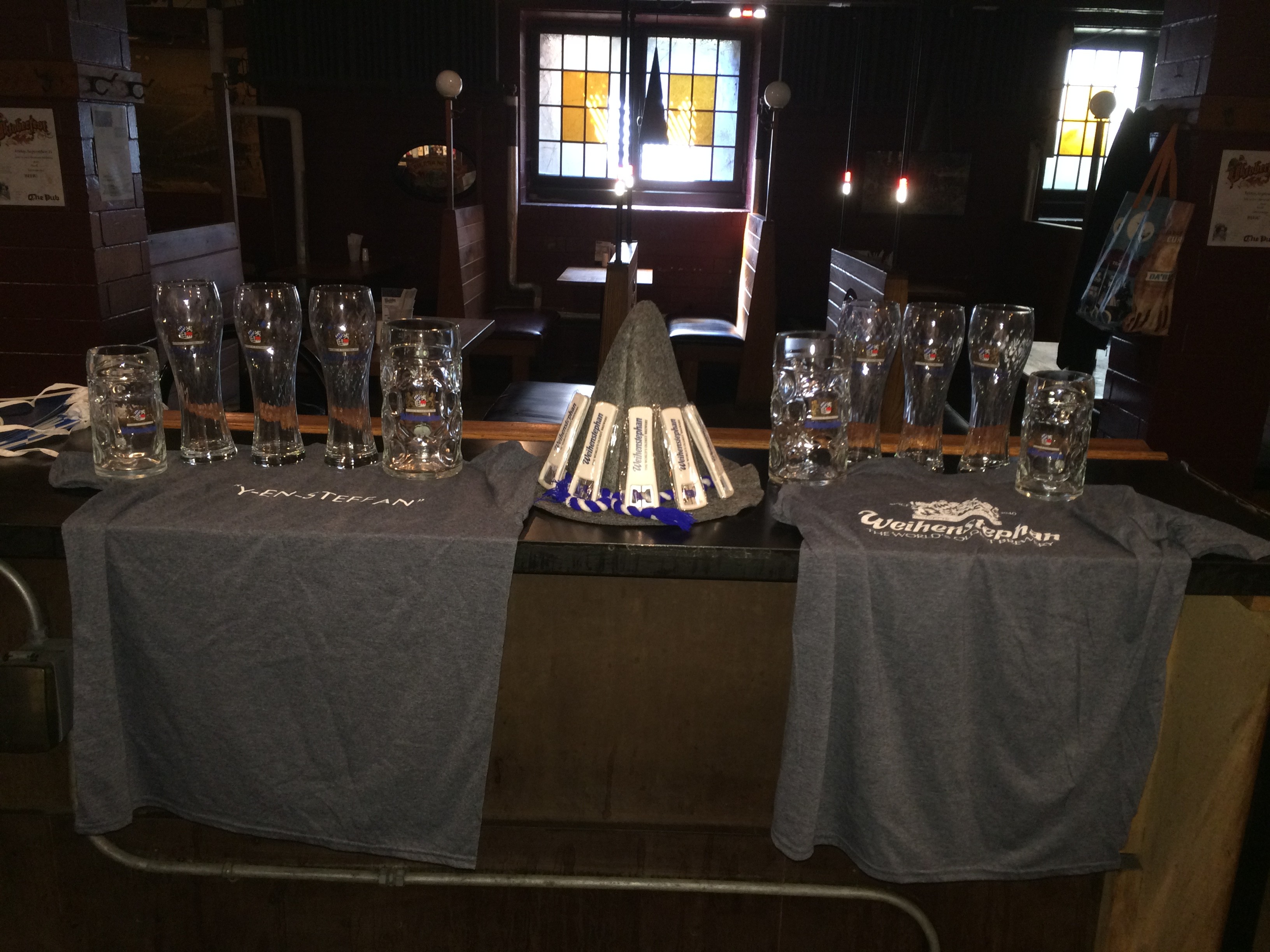Beer Passport — 3 Sheeps Cashmere Sweater and 5 Rabbit Vida y Muerte
Our Beer Passport program is one of the ways that we try to introduce our patrons to specific beers. With our passport selections, we want to introduce
- hard to find beers, one offs (beers brewed one time only) or new beers from brewers we love
- seasonal beers that we don’t want you to miss
- something crazy you might not try otherwise (like last year’s Bare Bear from Off-Color – had you ever even heard of the sahti style?)
- beers that demonstrate the creativity of craft brewers
- beers from newer or up and coming brewers.
With 1.5 new breweries opening every day, it’s impossible to try everything and it’s hard to know which beers are worth your time. We try hundreds of beers a year (and our distributors try even more than us!) in order to find excellent beers to serve. From time to time we like to use the passport program to introduce you to a core offering from a newer brewer or a brewer that we love. That’s why last week we had Fractal IPA from Penrose Brewing co. (a core offering from a newer brewer and rising star in the Chicago beer scene), and that’s why this week we are highlighting 3 Sheeps Cashmere Sweater Rye Stout on Nitro.
If you’ve been in The Pub in the last week and a half, you have probably seen this beer on our menu board. You may have even tried to order it. Unfortunately we’ve had some problems with one of our Nitro taps and had to turn a lot of people down. (I know, sad, right?) The problem is fixed, and so now we want as many people as possible to try this great beer. This brewer has only been around since 2012, and you may or not have had anything from them. Now’s your chance.
This beer is brewed specifically with nitrogenation in mind. For the unfamiliar, almost all beer is carbonated (meaning CO2 is added), like soda. Some beers, however, are nitrogenated (meaning NO2 is added). Guinness is the most common example. Nitrogen dioxide in beer provides much smaller bubbles than carbon dioxide, and the effects can be dramatic. First, the head is much creamier, so much so that the telltale wonder of a Nitro beer is the cascading that happens when you pour it. Unlike a carbonated beer, you don’t want to pour the beer gently into the glass. Second, the beer has an overall creamier body or mouthfeel. Third, comparing a nitro version of a beer with a non-nitro version reveals an incredible impact on flavor as well. If you tried Founders Rubaeus when we had it on nitro, then you surely noticed how much brighter and upfront the raspberry flavor was in the nitro version. Nitro can accentuate the subtle flavors of a beer and offset the aggressive, bitter flavors. Fifth, the aroma, or nose, of a nitro beer is subtler, as it’s harder for the aromas to penetrate the nitro head.
Cashmere Hammer was brewed specifically as a Nitro beer. To this end, the brewer started with Rye, which is often used in small quantities in a variety of beers for a spicy, dry effect. Too much rye can leave a beer feeling and tasting harsh, so it’s an ingredient that requires a master’s hand and an artisan’s creativity. This beer starts with the qualities of rye in mind and is designed to play with them in unexpected ways. The rye provides the boldness to punch through the nitro head for aroma, and the subtlety of the rye emerges as the harshness is palliated by the nitrogenation. The result (as with any good nitro beer) is a velvety smooth body, which is complemented by subtle rye flavor that lacks the aggressiveness typical of rye beers. (As an aside, the aggressiveness of rye can make it a great complement for the hoppy bitterness of an IPA, as in Founders Red’s Rye IPA or Great Lakes Rye of the Tiger.) The beer doesn’t disappoint the stout lovers either. This beer pours opaque and has the classic chocolate/coffee notes of a great stout. Rounding it out is a subtle dry finish.
As a bonus, we are also giving passport stamps for 5 Rabbit Vida y Muerte. We tapped this beer for Dia de los Muertos on Monday. Victor and Jody are in love with this beer. This beer is so good and so interesting, that one patron, when sipping a friend’s exclaimed, “I don’t like beer very much. I’d drink this over a cider!” Seriously – this beer is awesome.
The beer begins with a certain familiarity to those who enjoy Oktoberfest beers at The Pub. That’s because it’s loosely based on the traditional Oktoberfest märzen style. If that’s all there were to this beer, it wouldn’t be worth a passport selection. But, like Dia de los Muertos itself, this beer is a fusion of cultural influences typical of 5 Rabbit. Mexican beer is hugely influenced by the German brewing tradition, making the selection of a märzen style a fun beginning.
The next thing you’ll notice is the rich, caramel overtones. Dulce de leche (popular throughout Latin America) brings a delicate carameliness to the beer. This is the second way that the beer is in harmony with Dia de los Muertos, a holiday that combines pre-colonial and Spanish Catholic religious traditions to create something unique to the New World.
Finally, the middle, transitioning to the finish, is accented by two subtle additions. A touch of milk sugar, which is unfermentable, adds a very slight sweetness. This gives way to the specially chosen spices to create a delicate spiciness and imparts a coziness that is surprising in a beer.
Topping off the cultural fusion that is synonymous with 5 Rabbit and Dia de los Muertos, 5 Rabbit calls this style, “müerzen,” a clever bilingual pun that makes a word nerd like very happy.
Finally, from the 5 Rabbit description of the beer:
Vida y Muerte es nuestra cerveza para el Día de los Muertos. Una mezcla de tradicion católica y pre-colonial, que más que un recordatorio sombrío de la muerte, es una celebración de vida.
Enjoy one or both of these beers as tonight’s passport selection and collect up to two stamps.
Día de los Muertos (Day of the Dead) Celebration
November 2 is celebrated as Día de los Muertos in Mexico. The day is an opportunity to remember loved ones who have died and to honor the dead. Its origins predate Spanish colonization of Mexico, and like so many things colonized and appropriated by colonial powers in the Americas, Day of the Dead was merged with Spanish Catholic traditions to create the holiday as it known today. At The Pub, we celebrate today from open to close, as an opportunity for patrons to come together and remember their lost loved ones and to reflect on Mexican culture in an American context and what this represents about the American experiment of diversity and liberal democracy.
Originally celebrated during summer, the holiday originates among the Aztecs. With the arrival of the conquistadores in the Americas and the subsequent Catholicization of the indigenous peoples, and with attempts at eradication of the holiday failing, the Day of the Dead was moved to coincide with the Catholic holiday of All Hallows Eve, opening the door for the syncretistic celebration of traditional values and Catholic theology. At its core, which dates back some 2500-3000 years, the day is about celebrating life by acknowledging death. By remembering and honoring the dead, even young children learn not to fear death, but rather to accept it as part of the cycle of life and thereby empowering them to appreciate each moment of life. The day serves as a reminder that life is brief and death is natural.
With that preface, I’d like to make four points about The Day of the Dead, the Commercial application of holidays, and The Pub’s place on campus.
The Day of the Dead is not Halloween. This is an important point, particularly for non-Mexicans being introduced to the holiday for the first time. It’s easy for confusion to arise because of the presence of costumed individuals (dressing in bright colors and painting faces like skulls are both traditions) and the presence of sweets such as sugar skulls as well as the centuries old association of the Day of the Dead with Halloween in the Catholic Liturgical Calendar.

However, unlike the highly commercialized and thoroughly secularized American Halloween, Day of the Dead is highly symbolic and for many spiritually and religiously significant. It is not a day for debaucherous celebration of grotesque imagery, but rather a celebration of life and death. It is a day to honor the dead by remembering them.
Here are some good opinion pieces on this idea here and here.
Second, we support celebrating non-western or non-white holidays within a commercial setting and in the public domain. Why? Isn’t this simply crass commercialization and cultural appropriation? We would respectfully say no to both of these. When the only voices that are allowed to surface within an American capitalist structure are those that have belonged to power brokers (namely white European), we deny critical aspects of our pluralistic democratic Republic. At this particular moment in American public discourse, Mexicans, immigrants, and the Other have been disparaged and marginalized through policy and rhetoric by those who espouse authority as the political and economic leaders of this country. Along with other businesses (such as 5 Rabbit Cerveceria), we want to acknowledge the beauty of this subset of our populace.
As a business, we obviously want to make money. But we hope that anyone who has ever been into The Pub realizes that we are not trying to squeeze every cent possible from our patrons. We have a mission that accompanies the profit motive, and that centers on being a place for community and conversation. As such, we are trying to be true to the community we serve and the staff who makes The Pub what it is. Which brings us to point #3.
This day is particularly meaningful to our staff. Our staff’s connection to this day explains why we choose to celebrate this day at this time. Our staff is almost exclusively Mexican. Victor, the bar manager, has been with the company for 21 years. He was born in Chicago but grew up in Mexico in his traditional hometown of his family. The Pub (and The Medici) has been filled with Victor and his relatives for the last two decades, with as many as 21 staffers at Medici being part of his family at one time. Currently, six members of Victors family put in time at The Pub. If you come into The Pub with regularity, then you have definitely seen Victor and his cousin Hector giving each other grief and making The Pub what it is. As Mexicans, Victor and Hector were excited about the opportunity to share this part of their culture with pub patrons and to bring visibility to Mexican culture and heritage. By celebrating, we acknowledge that more than just one set of traditions matter.
The day is consonant with the mission of The Pub as a place for community. The Pub wants to be the place where classroom discussions continue; the place where friends gather to enjoy each other; the place where relationships deepen; the place where lifetime bonds are forged. We want to help people make new friends and celebrate with old friends. We want people to comfort each other in the bad times and celebrate with each other in the good times. With all of these expositions of the notion of community in mind, we felt that this holiday, with its deep connections to our staff, the resonance with our campus community, was a great expression of our mission of being a community space
We hope that you will enjoy Dia de los Muertos with us at The Pub. We have some great beers to celebrate tonight (including 3Floyds Zombie Dust and 5 Rabbit Vida y Muerte). You can find more about what we will be doing at The Pub tonight by checking out our Facebook event.
Penrose Fractal
American Craft Brewing, like so many things American, is about ingenuity. It’s about experimentation. It’s about asking questions like, “What if I put these two things together that everyone says shouldn’t go together?” There’s a long history and tradition surrounding Belgian beers. There’s a long history and tradition surrounding India Pale Ales (IPAs). There’s even a history (albeit shorter) of IPAs in American craft brewing. It’s therefore not surprising that American craft brewers would decide that they should play with Belgian influences when creating IPA recipes.
This brings us to Penrose. Penrose has only been open since early 2014, but they’ve already made a splash in the Chicago beer scene. (Yes, there is a Chicago beer scene, and Chicago is one of the most vibrant and interesting beer markets in the country.) Named the #7 brewery in Chicagoland by thrillist, these guys are doing some really interesting stuff.
The brewery was started by two former employees of Goose Island, the craft brewing legend and godfather of Chicago craft brewing, and they have proclaimed themselves as wanting to highlight yeast and its attributes in their beers. They’ve therefore created a list of core beers that can all be described as Belgian inspired or having Belgian characteristics. This means that when it came time to create an IPA, they created what’s come to be known in the craft beer world as a Belgian IPA or Belgo-American IPA. (For those wondering, the IPA originated in Britain in the 18th century.) The beer is Fractal, and it’s the Beer Passport Selection tonight at The Pub.
Fractal begins with two-row barley malt and carapils malt (a malt produced in Wisconsin, hi neighbors!). Two-row barley is a classic malt favored in European beers (over six-row barley malt that is favored by American macro-brewers for it’s higher enzyme content and concomitant potential for fermenting the most common adjunct in American macrobrews – corn). Nothing fancy, just a solid base. To this is added carapils, a malt that really just helps the beer have more consistent head and impacts the mouthfeel.
For hopping the beer, three hops varieties are used, none of which are particularly unusual, meaning they are well established and therefore provide characteristics familiar to American craft beer drinkers. First, there’s Cascade Hops. Cascade is the granddaddy of American Hops and American craft beer. Familiar from beers like Anchor Liberty Ale and Sierra Nevada Pale Ale, Cascade was the first hopes to come out of the USDA’s cultivation program in the 1950s and was made available to brewers in 1970. It has a long history in craft brewing and so should be familiar to you if you have tried very many IPAs or American pale ales.
Second in the hop bill is Columbus. This hop variety can be described as flashy insofar as it has a very pronounced aroma that can be described as dank, evoking marijuana or pine resin. It is used for bittering in beers and gives the beer a distinctively herbaceous aroma and taste.
Last but not least is Amarillo. This hop is familiar to many patrons of The Pub because of its prominence in 3Floyds Gumballhead. By industry folks, it is considered as a type of Cascade hop, but ultimately this hop variety is proprietary and grown by a single producer who owns a patent on the plant, Virgil Gamache Farms. This hop is used especially for its aroma, producing a floral-citrusy scent with spice notes throughout. It adds a similar flavor to beers that use it.
The star of Fractal, though, is the Belgian yeast, in this case a strain called Bastogne. History buffs (or fans of HBO’s Band of Brothers) will recall Bastogne as the site of an important WWII battle that was part of the larger Battle of the Bulge. As far as beer is concerned, Bastogne yeast is a strand of Trappist style yeast, most familiar to the casual American drinker in Dubbel and Tripel style beers.
The artistry of Fractal emerges from the way Penrose has brought together some familiar ingredients and made something distinctive out of them. They describe the beer as follows:
With notes of mango and fresh pine on the nose, this damn fine Belgian IPA is loaded with citrusy hop bitterness up front, and finishes with a dank, resinous flavor.
Generally speaking, we think that you’ll love this beer. You have to try it if you love Gumballhead, Sierra Pale Ale, or just generally love IPAs. It’s part of a group of beers that I like to call “Midwest IPAs,” because it is not aggressive, is very drinkable, and is eminently interesting. Let us know what you think in the comments section or talk to Victor to let him know if you like it.
5 Rabbit Gran Missionario 2015
From the brewer’s description:
“Gran Missionario celebrates the intersection of cultures that occurred in the missions set up all along the Pacific Coast of the Americas. Wheat and muscat wine grapes were among the plants brought over from Spain, being tasty as well as essential for church services.
Flaked wheat and oats add a rich creaminess to our base beer, substantial at 6.8% alc/vol. To that we add muscat of Alexandria, an “aromatic” grape grown at the Spanish missions. They have a perfumy, spicy quality that punches through the wheat and malt flavors. . . . [F]igs, which were brought to San Diego in 1760 . . . add a deep caramelly fruitiness to this dry and creamy beer.”
“Craft beer” is an interesting term. Technically, it’s just about production and ownership (more on this in another post). But the term evokes in the laymen something that is inherent in modern American beer brewing – creativity. Those familiar with German beer likely know about Reinheitsgebot – the Bavarian purity law of 1516 restricting the ingredients of beer to barley, hops, and water (with yeast being added to the law once it was understood what it did). Reinheitsgebot led, among other things, to the popularity of Pilsners in Bavaria and Light Lagers. This influence can be seen in the macrobrews dominating American beer, with Pilsners and Light Lagers dominating (though these come nowhere close to adherence to Reinheitsgebot, depending as they do on cheaper adjuncts like corn or rice for fermentable sugars).
All this serves as useful background for understanding what it is that craft brewers are attempting. Craft brewers are like chefs, with different philosophies, different influences, and different goals when it comes to palate manipulation. 5 Rabbit’s Gran Missionario highlights both the goals and influences of this particular brewer, but it also exemplifies the nature and spirit of American Craft Beer (if not the peak of the trends) and its similarities with creative cuisine.
First, note the use of certain traditional methods and ingredients. Despite the restriction on grain types in the Reinheitsgebot, wheat was widely employed in Europe (and especially Northern Germany) in beer making. Oats also had a long tradition in beer making. Moreover, how much more traditional do you want than using Belgian yeasT?
Second, note the creative use of additional ingredients. Grape must made from muscat of Alexandria grapes? If you don’t know wine, you probably don’t even understand the question! Grape must is freshly pressed juice containing seeds, stems, and skin of the fruit, and muscat of Alexandria is a white wine grape of ancient heritage. Wine grapes in beer? And what about figs? Nothing screams beer to me less than figs!
Third, the creativity is not just creative use of ingredients for the sake of being flashy (though that happens too!), but instead is meant to make an impact around a theme. This is where the influence of cuisine comes in. 5 Rabbit tries to celebrate Latin American culture and cuisine. This beer specifically is inspired by the missions that were a critical part of life in colonized Latin America (including California). So the wine and figs are not just there to be crazy and avant-garde. They evoke a heritage with twists and turns and various levels of absorption into this crazy place called America.
As you drink this beer, you’ll notice the grape must is let the beer linger on your tongue. The body is thicker than a lot of beers, and to me this is evocative of both the figs and of certain white wines (though I promise I know nothing of wine in earnest). There’s a sweetness that masks any of the bitterness of the beer (only 25 IBUs anyway), and a haziness that makes me feel like I just poured a nice juice.
So we are pouring 5 Rabbit Gran Missionario 2015, a double wheat with muscat of Alexandria grape must and mission figs as our beer passport this week to highlight the creative drive and the cultural influences that are possible in thoughtful American craft brewing. This beer highlights what is right with American brewing right now. So grab some tacos, a burrito, or an empanada, and enjoy a glass of this fine beer before it’s all gone.
Northwind and GravensTime
Tonight we have two different beers available for our Beer Passport. Why two? Because we want to make sure everyone gets a chance to fill out their passports and get a free t-shirt and pint glass! If you try both of them, you’ll get two stamps, meaning that if you missed last week, you aren’t out of luck.
The first selection is from Two Brothers – Northwind Imperial Stout, 2014.  Now, we expect that lots of our pub denizens have had this beer more than a time or two. However, what we have here is not just Northwind, but a barrel of Northwind from last year. Before you think we are just trying to pawn old beer off on you, there’s some things you should know about beer and aging. First, beer does not go bad when stored (if it hasn’t been opened). It does change though. And that change is what we are highlighting with this selection.
Now, we expect that lots of our pub denizens have had this beer more than a time or two. However, what we have here is not just Northwind, but a barrel of Northwind from last year. Before you think we are just trying to pawn old beer off on you, there’s some things you should know about beer and aging. First, beer does not go bad when stored (if it hasn’t been opened). It does change though. And that change is what we are highlighting with this selection.
Two Brothers has been playing around with cellaring some of their beers. Last year they set aside some barrels of this imperial stout to let it age. What happens to a stout when you let it age? First, the malty flavors become more prominent. You’ll notice this is like someone turned up the bass on Northwind. It’s maltier. It’s fuller. It’s bigger. Second, because it has a high alcohol content (9.1% ABV), some of the sharper elements will be rounded off or muted, leaving you with a more velvety finish. Third, hops deteriorate over time in beer, meaning that for really hoppy brews, you’ll find the most intense flavors when it is fresh (though aging hoppy beers can lead to some interesting results!). This means that in a beer where hops are not the most important aspect of the beer, like an imperial stout, the hops recede even further into the background, which contributes to that bigger, maltier feel.
So enjoy Northwind Imperial Stout, 2014 vintage. It goes down smooth with a clean finish.
Our second selection is from our good friends at Lagunitas. These guys are crazy.
They make an incredible IPA called Daytime (which they call fractional, meaning it’s only a fraction of a real IPA by ABV – or what everyone else calls a Session IPA). So what did they do? They decided to take 25% Daytime IPA and mix it with 75% cider made from Gravenstein and Granny Smith apples from Meyer Farming in Sonoma County. The result is off the wall. It sounds like a ridiculous thing to do, but the results are incredible. If you like IPAs and you like cider, then you have to try this. It’s tart, but that resiny-hoppy taste is prominent in a way that you won’t find with a cider. It’s also quite refreshing. This is a beer that highlights the creativity and artistry of brewing. There’s not that much of it in Chicago, so we hope you enjoy this!
We recommend trying both of these beers and collecting two stamps for your passport.
Surly Brewing Co., Minneapolis, Minnesota
Not everything survives Chicago. It’s a big place, with lots of competition, and Chicagoans can be particular about what we want. Starbucks even failed the first time it tried to move into Chicago. So if you’ve been around the beer scene for a while, you may have noticed that Surly was here for a while, then disappeared, and now is back. Maybe you think, wow, they must have not done so well. Au contraire mon frère! Surly was doing so well back in Minnesota, that people almost rioted because the beer was getting hard to find and Surly was shipping some off to Chicago. So they dialed it back until they had a greater production capacity. Now Surly is back in Chicago (and they just moved into Iowa and Wisconsin).
 So why am I starting a blog entry about Surly with this little anecdote? Because I think it’s hard to understand how good Surly is without understanding how fanatical people (here’s looking at you Minnesotans!) can be about it. And I want it to be clear that these beers are dynamite.
So why am I starting a blog entry about Surly with this little anecdote? Because I think it’s hard to understand how good Surly is without understanding how fanatical people (here’s looking at you Minnesotans!) can be about it. And I want it to be clear that these beers are dynamite.
So what do you need to know about Surly?
First, they are metal. I don’t mean they like heavy metal, or that they have a lot of synergy (the least metal word I know) with the metal scene. I mean, they are heavy metal – Todd Haug, the head brewer at Surly, not only listens to Heavy Metal when he brews beer, but was/is the guitarist for speed metal band Powermad.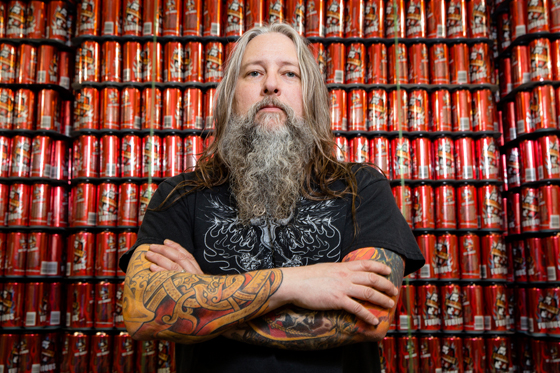
Second, they started selling their first beer, Furious IPA, in February of 2006. It’s a great IPA with influence from the British Extra Special Bitter (ESB) style. In this beer, you’ll find something that runs through a lot of Surly’s beers, giving them a unified character: Golden Promise malt. If you tried Todd the Axe Man at last year’s Docfilms The Shining event at The Pub, then you tasted the Golden Promise in full effect.
Third, their Russian Imperial Stout, Darkness, is a whale. If you can get it, ever, you must.
Fourth, they just opened a “destination brewery” (meaning you can come to the Brewery and also drink a pint) back in December. Their new brewery gives them the capacity to brew 100,000 barrels per year (for those not in the know, a Barrel = 2 Kegs). To get there though, they had to get a prohibition-era law changed. Seriously! Surly gets stuff done and they aren’t afraid to challenge the system!
Fifth, they kick major tail in Ultimate Frisbee. Seriously (Or surliously?). Five championships in two divisions.

We could go on about the brewery, but we won’t. Bottom line? This is a brewery that you have to know if you want to know craft beer in the Midwest specifically and in the U.S. generally. Believe me, once you drink some of their beers, you’ll be glad we introduced you.
Chris from Surly will be at The Pub on Thursday, October 8, from 5pm-7pm pouring samples of Furious IPA, Hell Lager, and Cacao Bender.
Beer Passport Kickoff — 5 Rabbit: Chinga Tu Pelo!
Tonight kicks off our quarterly beer passport. This is our opportunity to show off. We pride ourselves on having a robust and intriguing draft list. But our Beer Passport picks are always something special that we want to be make sure you’ve tried. They’re a little funky, a little special, a new release, something hard to find, or a great beer from an up-and-coming brewery we’re excited about. Follow us on twitter [@UofCPub] to find out each Wednesday’s pick or look for more information on this blog. Of course, you can always just come in on Wednesdays and ask for the beer passport selection.
To participate: Come by on Wednesdays the 1st-10th week of the quarter and order our Beer Passport selection. Be sure to request a passport—for the laudable achievement of obtaining at least 8 stamps in a quarter, we will bestow upon you a t-shirt to commemorate your accomplishment. If you get all the way to 10, we’ll also give you a pint glass. Cool, huh?
We already have the pint glasses and the T-shirts designed, and they should be in within a couple of weeks.
So we couldn’t thing of a better way to start this year’s passport program than with a beer from America’s original (and only) Latin American inspired brewery: 5 Rabbit Cerveceria’s Chinga Tu Pelo.
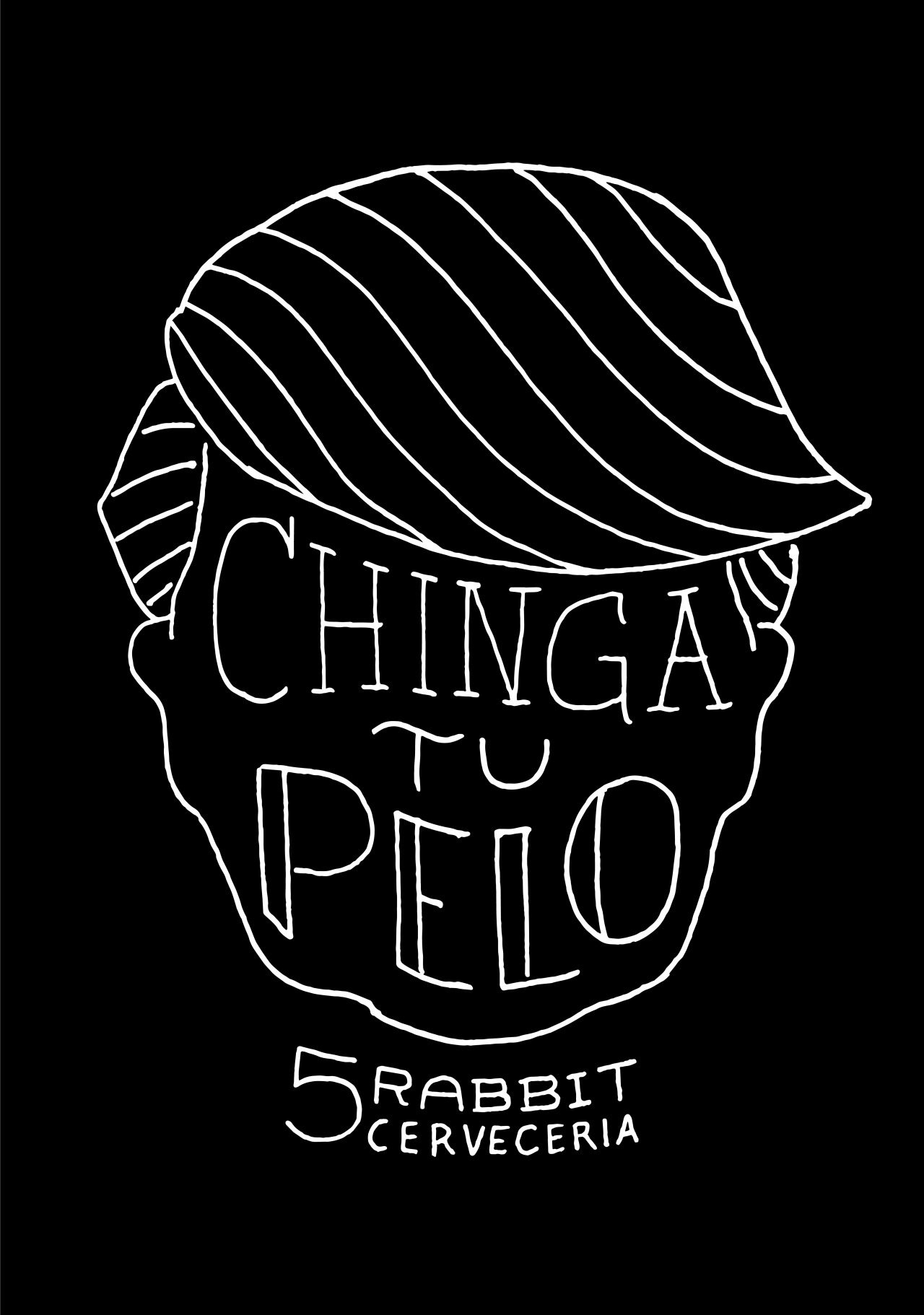
 Once you get to the end of this blog post, I hope it’s clear why it’s our first passport selection. So 5 Rabbit, let’s start with 5 words:
Once you get to the end of this blog post, I hope it’s clear why it’s our first passport selection. So 5 Rabbit, let’s start with 5 words:
Donald. Trump. Running. For. President.
What could possibly go wrong?
Well, for starters, he insulted a lot of his business partners.
After making some colorful comments about Mexican immigrants (okay, Ivanka, I hear you. He insulted “illegal Mexican immigrants.” How exactly does that make it better?)
We aren’t into politics here at The Pub, so what does this have to do with beer, you ask? Well, Chicago Brewer 5 Rabbit Cerveceria had a contract to brew an exclusive beer for Trump Tower’s Rebar in Chicago. The problem for Trump is that Andrés Araya, accomplished businessman, all around good guy, and co-owner and founder of 5 Rabbit is a Costa Rican immigrant who planned his brewery while living in Mexico. Moreover, 5 Rabbit is a brewery inspired by and dedicated to the creativity of Latin American culture. I’ll let Andrés explain:
“We would be doing an injustice to the community we serve (and live in) by engaging in business with someone who does not accept our role in society and expresses a rhetoric of hate and ignorance towards us” (Araya in a letter to WBEZ in Chicago)
So 5 Rabbit cut ties with Trump Tower and Trump. But let’s be honest, no self-respecting brewer is pouring out quality beer that represents a lot of creativity and hard work, the same hard work that Trump said Mexican immigrants weren’t engaged in. 5 Rabbit reportedly had 50 barrels or so left in the warehouse, and after a brainstorming session (and a few conversations with lawyers, no doubt), they settled on renaming the beer, “Chinga tu pelo!” which translates to, “F*$% your hair!” All the barrels were gone almost immediately. (For the record, when I told Victor and Hector about the new name of this beer, they lost it.)
But fear not dear pub dwellers! They brewed one more batch, and The Pub has a keg. Trump is concerned about immigrants not having a valid passport, so we thought it only fitting to say, “Chinga tu pelo!” as we give you a passport and stamp it to kick off the year.
So what’s the beer like? It’s a Golden Ale coming in at 3.5% ABV, so it’s really easy drinking. If you are new to craft beer, then this is a great choice because Golden/Blonde ales tend to be very approachable and can highlight what you’re missing if all you drink is American macrobrews. So grab a pint. Get your passport, and get on your way to that free pub t-shirt. Oh, and we won’t let “the Donald” kick you out of The Pub.
Penrose — Deminimus Roux
One of the latest trends in craft beer is the sour. If you really want to know all about sour beer, check out Penrose’s website here or use the google. What is a sour beer? Simply put, it’s a beer that is brewed to taste sour! The key to making a beer sour is the introduction of lactic acid, as acidity correlates with sour flavor. Yeast is used in beer brewing to convert the sugars in the malt into alcohol. In a sour beer, a bacterium like lactobacillus, is introduced, which converts the sugars in the malt into lactic acid. By controlling the lactic acid production, the brewer can achieve a certain level of sour.
With its Deminimus series, Penrose has created approachable sours that can be consumed in some quantity (due to their low alcohol content). They are calling them sessions sours. Deminimus Roux was our favorite when we tasted it, and so we’ve brought it into The Pub for you to enjoy. Clocking in at only 4% ABV, it is genuinely a beer that you can drink for an entire session. It has a pH of 3.45, making it about as tart as orange juice. It has a bitterness of 14 IBU (compared to your typical IPA, you may not even notice the bitterness). Penrose describes this beer as follows: “Huell Melon hops showcase red berry and ripe watermelon characteristics before journeying into a fruity malt balance and a dry, tart finish.”
(Huell Melon is a hops variety created by a research group in Huell, Germany. It’s a daughter to Cascade hops, and is used primarily for aroma and secondarily for flavor. The creators dubbed it “melon” because it evokes honeydew and watermelon on the nose.)
Overall, we think Deminimus Roux is an eminently approachable sour from a really cool, up and coming Chicago Brewer (okay, they’re in Geneva, but you don’t know where that is). These guys are super nerdy and really belong at The Pub on trivia night. It’s perfect for drinking a few of these and still be able to answer trivia questions. That’s why Victor has made this his pick for the first Trivia night of the year.
Sour Power!
Oktoberfest!
Join us to celebrate Oktoberfest at The Pub today from 4pm until we close at 1am. Why are we celebrating Oktoberfest? Let me count the ways!
First, it’s Oktoberfest.
Second, there are some amazing Oktoberfest beers. We have this, this, and this on tap right now.
Third, Oktoberfest is a celebration of fall and a chance to come together and socialize. (The first one was a wedding celebration!) Fall at the University of Chicago is an exciting time as new students arrive on campus, returning students return from summers of awesomeness, and an authentic spirit of newness permeates the air. So Oktoberfest is the perfect festival for back to school and giving upperclassmen, new graduate students, and returning graduate students the chance to mingle and meet each other.
Fourth, you may not know it, but the Morsbachs, the family that brought you the Medici on 57th and who has run The Pub for 30+ years is a Bavarian family who immigrated to Hyde Park. We take pride in being a small, family run business, and this is a way of inviting you to join a family celebration!
Fifth, it’s Oktoberfest.
So what can you expect at our Oktoberfest party?
A little of this:
Some of this.
A lot of this. And this. And this. And this is how Mexicans do German beer. (Lots of Mexican beer is in a German style, in case you didn’t know!)
Oh, and we are giving away stuff all night long. Every hour, on the hour (or close enough for a bar without a working clock) We’ll start around 5:00 (and if a lot of people are here, we’ll do some giveaways before that!) or whenever else we feel like throwing some swag your way. Here’s some of the stuff we’ll be giving away:
If you want to know more about the History of Oktoberfest, check this out.
What else is there to say? Oh yeah. Prost!
Solemn Oath: Punk Rock for Rich Kids
Our Beer Passport doesn’t officially start until Wednesday September 30, but we’re open tonight, we have a really cool beer in the cooler, and we just can’t wait to start the year. So, tonight everyone can start their passport, knowing that they have an extra week to fill their passport. Yeah, we kind of rock. (By the way, we already have the shirts and pint glasses designed, and they’ll be headed to the printer soon. You won’t want to miss them.) Now on to tonight’s Beer Passport Selection: Solemn Oath’s Punk Rock for Rich Kids
One of the great things about craft beer (versus aged spirits like bourbon or even wine) is that brewers can play around and experiment and see (and taste!) the results of their creativity in a relatively short amount time. Creativity is at the heart of the modern craft beer scene, and no one knows this more than the guys at Solemn Oath.
These Naperville brewers love to try new things and they bring this love of the unknown into their brewing. The beer offerings are constantly changing. And, with beer names like Axe Scar Pig, Ravaged by Vikings, and Nonsequitur Metaphor, you can tell that these guys have a sense of humor. Punk Rock for Rich Kids might be one of the best beer names out there, and fortunately for us, it’s also an amazing beer.
Billed as a “Single Hop Belgo-American Pale Ale,” this beer is brewed with Belgian yeast strains, but in the style of an American Pale Ale. You’ll notice the Belgian yeast when the fruity notes hit your tongue. This beer is brewed quarterly with a different hops each quarter. This batch highlights Huell Melon hops. The hops is balanced by a light caramel sweetness. At 5.5% ABV and 47 IBU (international bitterness units), this beer is just right for kicking off a night at The Pub.
Disclaimer: If we run out, we’ll put something else awesome on, but don’t get mad at us! It’s not our fault if people love our beer. (Okay, maybe it is our fault.)
Let us know what you think in the comments, including tasting notes, did you like it, etc.


